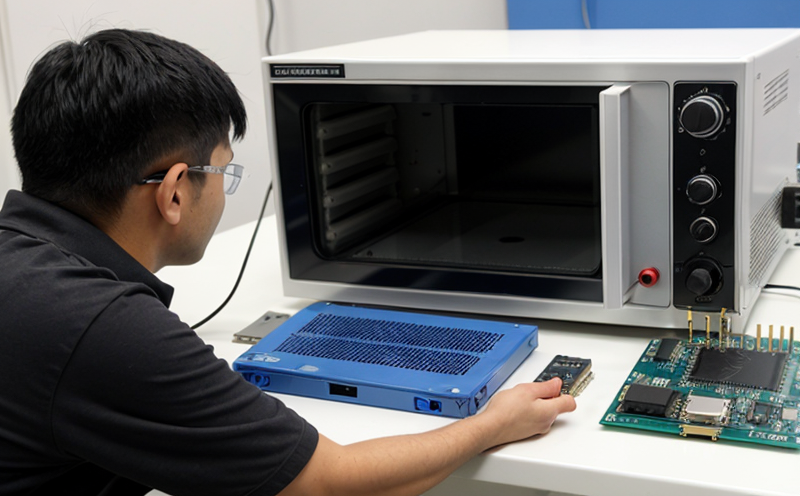ASTM F1400 Thermal Shock Testing for Microelectronic Materials
The ASTM F1400 standard provides a comprehensive approach to testing the thermal shock resistance of microelectronic materials. This test is crucial in ensuring that these materials can withstand extreme temperature changes without compromising their integrity or performance.
Thermal shock testing simulates real-world conditions where components are subjected to rapid and significant temperature variations, such as during manufacturing processes, transportation, or use. The ASTM F1400 method evaluates the ability of microelectronic materials to endure these changes by exposing them to a controlled sequence of thermal cycles.
The test setup involves placing the sample in an environmental chamber that can rapidly change temperatures. The specimen is initially equilibrated at one temperature, then subjected to another extreme temperature within a short period (typically less than 10 minutes). This cycle may be repeated multiple times. The choice of initial and final temperatures depends on the specific material being tested but often includes extremes such as -55°C and +125°C.
The ASTM F1400 standard provides detailed guidelines for testing procedures, including specimen preparation, environmental chamber conditions, temperature cycling rates, and duration of exposure. Compliance with this standard ensures that microelectronic materials are rigorously tested to meet the stringent requirements demanded by various industries.
Understanding the importance of thermal shock resistance is essential in the electronics sector where reliability and performance under diverse operational environments are critical. This testing method helps manufacturers ensure their products can withstand harsh conditions, thereby enhancing product longevity and customer satisfaction.
| Industry | Application |
|---|---|
| Automotive Electronics | Testing for durability under fluctuating environmental conditions during vehicle operation. |
| Aerospace Electronics | Evaluating materials used in space and aircraft electronics to ensure reliability in extreme environments. |
| Military Electronics | Assessing the performance of components used in military applications under severe environmental stress. |
| Consumer Electronics | Ensuring that products can withstand the temperature variations encountered during shipping and usage. |
The ASTM F1400 standard plays a vital role across these industries by providing a uniform methodology for evaluating thermal shock resistance. This ensures that all tested materials are assessed under consistent conditions, enhancing comparability and trust within the industry.
Scope and Methodology
The ASTM F1400 scope covers the testing of microelectronic materials to determine their ability to withstand rapid changes in temperature. The primary objective is to assess the mechanical properties, electrical performance, and overall integrity of the material after exposure to thermal shock.
Testing involves placing a sample inside an environmental chamber that can precisely control the temperature. Initially, the specimen is equilibrated at one set temperature for a specified duration. It is then rapidly cooled or heated to another predetermined temperature within a short time frame. This cycle may be repeated multiple times depending on the specific requirements of the test.
The ASTM F1400 standard specifies the exact parameters for this testing, including:
- Temperature ranges
- Cycling rates
- Durations for each temperature phase
- Environment conditions inside the chamber
Following the completion of the test cycles, inspectors evaluate the specimen to determine if any damage has occurred. Common checks include visual inspection for cracks or visible deformation and electrical testing to ensure functionality.
The results from ASTM F1400 thermal shock testing are crucial in quality assurance processes. They provide valuable insights into the reliability and durability of microelectronic materials, aiding manufacturers in improving product design and enhancing overall performance.
Industry Applications
| Industry | Application |
|---|---|
| Aerospace Electronics | Evaluating the resilience of materials used in space and aircraft electronics. |
| Automotive Electronics | Assessing durability under fluctuating environmental conditions during vehicle operation. |
| Military Electronics | Ensuring reliability in extreme environments for military applications. |
| Consumer Electronics | Enhancing product longevity by ensuring components can withstand shipping and usage conditions. |
| Medical Devices | Evaluating the performance of medical devices under temperature variations encountered during transport or use. |
| Data Centers | Assuring that server and storage components are robust enough to handle temperature fluctuations within data centers. |
| Telecommunications Equipment | Evaluating the reliability of telecommunication equipment in diverse environmental conditions. |
The ASTM F1400 standard is widely used across these industries, providing a standardized method for evaluating thermal shock resistance. This ensures that all tested materials are rigorously assessed under consistent conditions, enhancing comparability and trust within the industry.
Quality and Reliability Assurance
- Data Analysis: Comprehensive analysis of temperature cycling data to identify trends and patterns in material performance.
- Failure Analysis: Detailed examination of any sample failure during or after testing to pinpoint specific weaknesses.
- Non-Destructive Testing (NDT): Utilization of NDT techniques to check the integrity of materials without causing damage.
- Material Compatibility: Ensuring that different components are compatible with each other under thermal shock conditions.
- Environmental Simulation: Re-creating real-world environmental stressors in a controlled laboratory setting for thorough evaluation.
- Statistical Process Control (SPC): Applying SPC to monitor and control the testing process, ensuring consistent results across multiple tests.
- Failure Mode and Effects Analysis (FMEA): Identifying potential failure modes in microelectronic materials and their effects on overall system performance.
- Root Cause Analysis: Determining the underlying causes of any failures observed during testing to implement corrective actions.
The ASTM F1400 standard is integral to these quality assurance processes, providing a robust framework for evaluating thermal shock resistance. By adhering to this standard, manufacturers can ensure that their products meet stringent reliability and performance standards, thereby enhancing customer trust and satisfaction.





